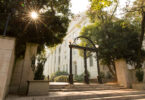Suitcase Paintings: Small-Scale Work by Abstract Expressionists is on display until July 22 at the Georgia Museum of Art.
The abstract expressionists pushed the limits of scale in their art and used their canvases to express their emotions as they saw fit. The expressionists used every inch of their large canvases, though they treated each spot with equal importance.
However, the artists in this exhibition also created smaller works of intense beauty without losing this energy, creativity and detail.
Abstract Expressionism originated in New York City shortly after World War II. It was the first notable American art movement to achieve worldwide influence.
Robert Richenburg, Melville Price and Franz Kline were all Abstract Expressionists inspired by Willem de Kooning during the 1940s and 1950s. They all lived in New York during the height of their creative careers and painted abstractly by focusing on brushstrokes rather than details.
Richenburg (1917–2006) used war for inspiration and was known for his dark paintings. After returning to the U.S., Richenburg moved to New York and immediately started painting. He was an active member of the Artist’s Club and, in 1951, was asked by Leo Castelli to participate in The 9th Street exhibition, organized by the Artist’s Club to help recognize artists who had served in the war. He began teaching later that year, a job that he would hold for the rest of his life.
Price (1920–1970) was born into an affluent family in Kingston, N.Y. In his early 20s, he obtained work through the New Deal’s Works Progress Administration, which gave artists jobs painting educationally encompassing national and regional historical themes. Through the WPA, Price met many other artists including Kline, who became a lifelong friend. In 1948, Price’s work was shown in several group exhibitions and, by 1949, he had his first solo exhibition.
Kline (1910–1962) was born in Wilkes Barre, Penn. A football injury during his childhood sparked Kline’s interest in drawing. He studied at the Boston Art Student’s League and later moved to England, enrolling at Heatherley’s School of Fine Art in London. After returning to the U.S., he settled in New York. Although he had a slow start, Kline’s reputation exploded after his first one-man exhibition at the Egan Gallery. He is best known for his black-and-white paintings inspired by architectural and industrial icons.




